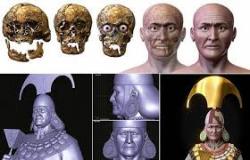INSTITUT SUPERIEUR D'ANTHROPOLOGIE
INSTITUTE OF ANTHROPOLOGY
ONLINE COURSES / COURS A DISTANCE
FALL TERM : OCTOBER 2016
REGISTER NOW
INDONESIE –  Liang Bua - According to a report in Nature, archaeologist Thomas Sutikna and geochronologist Richard Roberts of the University of Wollongong say that two teeth from modern humans have been found in the Indonesian cave where the remains of Homo floresiensis were discovered in 2003. The teeth have been dated to 46,000 years ago, making them slightly younger than the estimated date for the extinction of the hobbits some 50,000 years ago. The upper premolar and lower molar are larger than the teeth of H. floresiensis, but some scholars are not convinced that they belonged to a modern human. Other evidence for the presence of modern humans in the cave after the hobbits disappeared includes fireplaces and freshwater mollusk shells. “What we don’t yet know is whether there was at least a short overlap in the populations, thus raising the question once again of the possible role of modern humans in the extinction offloresiensis,” commented paleoanthroplogist Chris Stringer of the Natural History Museum in London.
Liang Bua - According to a report in Nature, archaeologist Thomas Sutikna and geochronologist Richard Roberts of the University of Wollongong say that two teeth from modern humans have been found in the Indonesian cave where the remains of Homo floresiensis were discovered in 2003. The teeth have been dated to 46,000 years ago, making them slightly younger than the estimated date for the extinction of the hobbits some 50,000 years ago. The upper premolar and lower molar are larger than the teeth of H. floresiensis, but some scholars are not convinced that they belonged to a modern human. Other evidence for the presence of modern humans in the cave after the hobbits disappeared includes fireplaces and freshwater mollusk shells. “What we don’t yet know is whether there was at least a short overlap in the populations, thus raising the question once again of the possible role of modern humans in the extinction offloresiensis,” commented paleoanthroplogist Chris Stringer of the Natural History Museum in London.
http://www.nature.com/news/human-remains-found-in-hobbit-cave-1.20656
PEROU –  Sipan - The face of Peru's iconic Lord of Sipan has finally been unmasked some 1,900 years after his death, all thanks to technology which has built a 3D reconstruction of the ancient warrior's face. With the help of Brazilian experts, archaeologists have created a 3D model of the Lord of Sipan's face. The team of investigators who worked on the project included odontologists and forensic experts, replicating the ancient face of the warrior down to the smallest details. The Lord of Sipan is from the ancient Moche civilization. His tomb was discovered untouched in 1987 and has provided with archaeologists with new insights into the Mohican society. The Moche civilization flourished on Peru's northern coast between about the years 1 and 800 CE, a rural area of the South American country made up largely of farmers and fishermen.
Sipan - The face of Peru's iconic Lord of Sipan has finally been unmasked some 1,900 years after his death, all thanks to technology which has built a 3D reconstruction of the ancient warrior's face. With the help of Brazilian experts, archaeologists have created a 3D model of the Lord of Sipan's face. The team of investigators who worked on the project included odontologists and forensic experts, replicating the ancient face of the warrior down to the smallest details. The Lord of Sipan is from the ancient Moche civilization. His tomb was discovered untouched in 1987 and has provided with archaeologists with new insights into the Mohican society. The Moche civilization flourished on Peru's northern coast between about the years 1 and 800 CE, a rural area of the South American country made up largely of farmers and fishermen.
VIDEO = http://www.reuters.com/article/us-peru-archaeology-idUSKCN11S20O?rpc=401
INDE - Kancheepuram / Tiruvallur - On its third day, the seminar on Ancient History and Archaeology of Chennai Region, organised by the State Archaeology Department and Chennai 2000 Plus Trust, opened up a world of ancient temple inscriptions in Kancheepuram and Tiruvallur. The lecture and presentation by R Sivanantham, deputy director (in-charge), Department of Archaeology, focused on over 100 out of 2,000 inscriptions that have been found in these districts, and threw light on their social and cultural significance today. He started with the prehistoric period and went on to cover the Netrampakkam inscriptions of 3rdC AD and its Shiva idol with Tamil Bhrami script; the rock cut cave temples of 7th century AD, dating back to the period of Mahendra Pallavan, and the earliest inscriptions by Nandi Varman. Among the many inscriptions discussed were those found in Thirumukkudal in Kanchipuram, which Sivanantham said are also the largest inscriptions on a single stone in India, at a height of 55ft and on an area of 540sqft. Created under Veera Rajendra Chola in 1068 AD, these also give a detailed reference to the earliest medical college. "It also talks of designated staff, including doctors, surgeons and nursing staff and assistants," says Sivanantham. Similarly, Tamil inscriptions in Uthiramerur and Thiruninravur from that period reveal a fascinating structure of governance.
http://timesofindia.indiatimes.com/city/chennai/Ancient-inscriptions-reveal-systemic-governance-practice/articleshow/54472020.cms